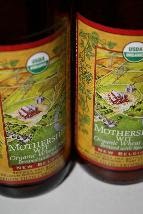 Tonight I am posting the review of a Strong English Bitter. We discussed some of the differences between a standard Bitter, and a Strong Bitter in the last post so I don't feel the need to go into too much detail here, but I will discuss some of the characteristics of a traditional English Bitter, because I feel this beer has little in common with the traditional style.
Tonight I am posting the review of a Strong English Bitter. We discussed some of the differences between a standard Bitter, and a Strong Bitter in the last post so I don't feel the need to go into too much detail here, but I will discuss some of the characteristics of a traditional English Bitter, because I feel this beer has little in common with the traditional style.The beer is the Old Goat Strong Bitter, and the brewer is Cropton Brewery. Cropton Brewery is based in North Yorkshire (North England), just outside of the city of Pickering, in the small village of Cropton. As far as their other beers are concerned, they brew a wide range of beers from American Style IPA's to Imperial Stouts, and from Porters to Golden Ales. They also brew their house favorite: Two Pints, a tradtional style cask-aged English Bitter. Ok so now let's move on to discussing the characteristics of a good English Bitter.
Reading the side of the bottle of Old Goat, it states: "A pale English ale with a malty flavour finely balanced with fine English hops to give a hint of citrus and a surprisingly smooth finish for such a strong beer." Now the reason I bring this to your attention is because this is exactly what a good Strong Bitter should taste like. They should be well-balanced, equally malty and equally hoppy, some will undoubtedly gravitate towards one side or the other, but in general, the beer should exhibit both of these qualities, and that's just how it is. Unfortunately, this brew (maybe I just chose a bad or old bottle) was not at all what the description on the side claimed it would be. Upon tasting this beer I was disappointed (partly because it traveled with me from London, to Edinburgh and St. Andrews, back to London, and ultimately across the English Channel to Amsterdam, where it was consumed) and partly because I was hoping for a nice, balanced, perhaps somewhat hoppier than average, malty English ale. Instead, I received something unbalanced, exploding with citrus, and only just a hint of malt. Reading some other reviews online, it would seem there were others who tasted the same things as I, but there were also others that found this beer to be quite good, quite malty, and as the bottle claimed, well-balanced. So casting aside all judgements, most likely this was just a bad batch. Regardless, the offering left a bad taste in my mouth, and in my mind. I would never base my opinion of a brewery on one beer, and would definitely try another if given the chance. Ok, onto the beer :]
Name: Old Goat
Category/Style: Strong Bitter
ABV: 8.0%
IBU: Unknown
OG: Unknown
FG: Unknown
Malt Types: Unknown
Hop Types: Unknown
Yeast Type: Unknown
Special Additives: Unknown
Bottled: Unknown
Bottle Size: 500 mL
Location Purchased: Nelsons, Merton, England
The Pour: Hazy dark yellow amberish, head is white, not very good retention, but lacing is ok.
The Nose: Bright and fruity, slightly skunky/musty, sour apple juice, white grapes, grassy hops, a hint of maltiness there somewhere, sweet and caramely, a bit of alcohol and spice, slight hints of yeast, white wine, and apple pie.
The Taste: Surprisingly sour (almost like biting into a lemon), somewhat salty. A little bite initially, flavor of sour apples and white grapes, a little citrus, some metallic notes. A low, bubbly carbonation, medium bodied. Is a bit astrigent, there is white wine on the finish, slightly bitter, a little warming on the back of the throat, but something seems a tad bit off with this one.....
The Verdict: Not at all what I was expecting; this could be a good thing or a bad thing......but definitely very different from any other english bitter I've ever tasted. Did not detect any hint of malt in the flavour (they claimed it would be a strong malty flavour). Read some other online reviews that suggested the same things, but I really just didn't expect it to be so sour....explain to me why an english bitter is so sour? The flavor left in my mouth a few minutes after polishing off the bottle is not delightful in any way....so that leaves me to believe that this different version of an english bitter is not a good thing. My recommendation for this brew is not to recommend it, if you get my drift ;] There are much better examples of strong english bitters out there. Just a bit disappointing since I traveled with this bottle of bitter for so long..............
Thanks for reading!
Zach




.jpg)






.jpg)

.jpg)



+(size+edit).jpg)
.jpg)




